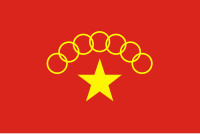The Myanmar National Democratic Alliance Army (MNDAA)[n 1] is an armed resistance group in the Kokang region of Myanmar (Burma). The army has existed since 1989, having been the first one to sign a ceasefire agreement with the Burmese government. The ceasefire lasted for about two decades.[4][5]
| Myanmar National Democratic Alliance Army | |
|---|---|
| 缅甸民族民主同盟军 မြန်မာ့အမျိုးသားဒီမိုကရက်တစ်မဟာမိတ်တပ်မတော် | |
 Official logo of the MNDA(rendered online) | |
| Leader | Pheung Daxun[1] |
| Dates of operation | 12 March 1989 – present |
| Active regions | Kokang, Myanmar |
| Ideology | Kokang nationalism |
| Size | 6,000+[2] |
| Part of | |
| Allies | Northern Alliance[3] Other allies |
| Opponents | |
| Battles and wars | Internal conflict in Myanmar |
| Flag |  |
| Website | mndaainfo |
| Myanmar National Democratic Alliance Army | |||||||
|---|---|---|---|---|---|---|---|
| Simplified Chinese | 缅甸民族民主同盟军 | ||||||
| Traditional Chinese | 緬甸民族民主同盟軍 | ||||||
| |||||||
History
The group was formed on 12 March 1989, after the local head of the local Communist Party of Burma, Pheung Kya-shin (also spelt Peng Jia Sheng or Phone Kyar Shin), dissatisfied with the communist government, broke away and formed the MNDAA.[6] Along with his brother, Peng Jiafu, they became the new unit in Kokang.[7] The strength of the army is between 1,500 and 2,000 men.[7]
The rebels soon became the first group to agree to a ceasefire with the government troops. As the first group in the Shan State area to sign a ceasefire, the Burmese central government referred to the Kokang region controlled by the MNDAA as "Shan State Special Region 1" (Chinese: 缅甸掸邦第一特区; Burmese: မြန်မာနိုင်ငံ ရှမ်းပြည်နယ်အထူးဒေသ (၁)).[6] After the ceasefire, the area underwent an economic boom, with both the MNDAA and regional Myanmar Armed Forces (Tatmadaw) troops profiting from increased opium harvests and heroin-refining.[8] The area also produces methamphetamine.[9] The MNDAA and other paramilitary groups control the cultivation areas, making them an easy target for drug trafficking and organised crime groups.[9] The Peace Myanmar Group allegedly launders and reinvests MNDAA's drug profits into the legal economy.[10]
2009 Kokang conflict
In August 2009, the Myanmar National Democratic Alliance Army became involved in a violent conflict with the Myanmar Armed Forces. This was the largest outbreak of fighting between ethnic armies and government troops since the signing of the ceasefire 20 years earlier.[11]
As a result of the conflict, the MNDAA lost control of Kokang, and as many as 30,000 refugees fled to Yunnan province in neighbouring China.[12] The Kokang area became the Kokang Self-Administered Zone on 20 August 2010, however, it was recognized as illegal by MNDAA.[13][14]
2015 offensive
On 9 February 2015 the MNDAA tried to retake the area, clashing with Burmese government forces in Laukkai. The skirmishes left a total of 47 Government soldiers dead and 73 wounded. After several months of intense conflict, Kokang insurgents had failed to capture Laukkai. Following the incident, the government of China was accused of giving military assistance to the ethnic Kokang soldiers.[15]
2017 clashes
On 6 March 2017, MNDAA insurgents attacked police and military posts in Laukkai, resulting in the deaths of 30 people.[16][17]
2021 post-coup resistance
Clashes with the Tatmadaw resumed after the military coup, with MNDAA alongside its allies, the Arakan Army and Ta'ang National Liberation Army, attacking a police station south of Lashio, killing at least 14 police officers and burning the station to the ground.[18] MNDAA and TNLA further launched attacks in multiple locations in Northern Shan State on 4 and 5 May 2021, inflicting heavy casualties on the Myanmar military.[19]
The MNDAA were involved in Operation 1027 in October 2023, launching coordinated attacks and seizing junta outposts ranging from Lashio to Hopang Township in northern Shan State.[20][21]
On 28 October 2023 it was reported that Chinshwehaw had come fully under control of the MNDAA during the ongoing civil war.[22]
On 5 January 2024, MNDAA gained full control of Laukkai, the capital of Kokang, following a mass surrender of the last Burmese military junta forces.[23][24] In the same day, MNDAA claimed the "liberation" of Kokang.[25]
See also
Notes
References
External links
- "Myanmar clashes with rebels 'kill 47 soldiers'". BBC News. 13 February 2015.
- "Myanmar govt forces in pursuit of Kokang ethnic army". Xinhua. 12 February 2015.